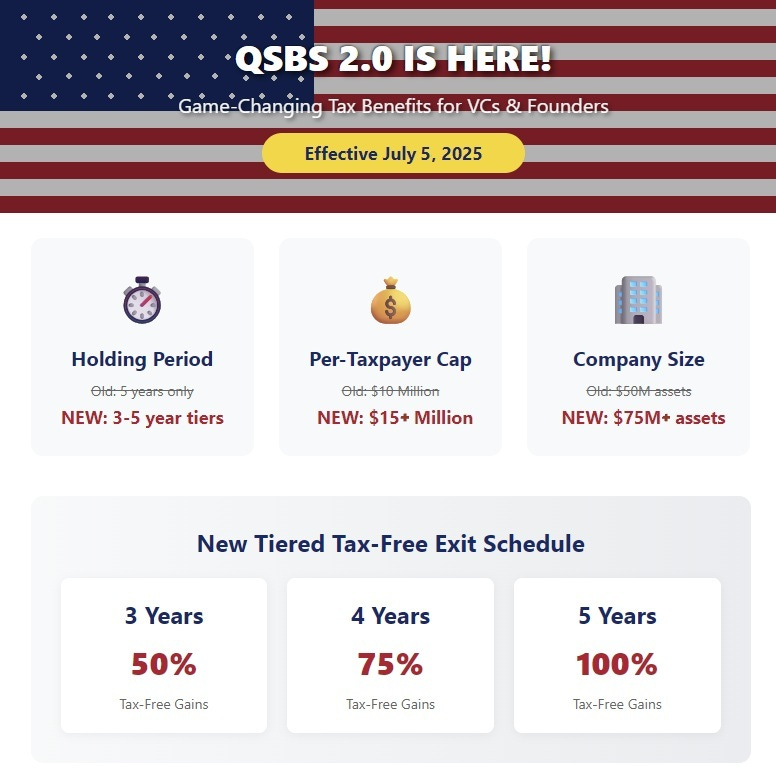On July 4, 2025, the One Big Beautiful Bill Act (OBBBA) quietly reshaped a tax incentive that’s been a bedrock of early-stage investing: Qualified Small Business Stock (QSBS). The last overhaul was in 2010. This one’s bigger—and faster.
To break it down, we’re turning to someone who knows the letter and the strategy behind the law: Chris Harvey, attorney and founder of Law of VC. Chris has helped funds, founders, and LPs navigate QSBS for years—and his analysis of the new law is the go-to reference for this update.
Link here: #33 Episode - QSBS 2.0 is Here
As he puts it, “This is the most material update to QSBS in 15 years.” And it's not just cosmetic. QSBS 2.0 shifts timelines, raises caps, and reopens the door for companies and funds that thought they’d aged out.
🚀 3-Year Exits Now in Play
QSBS is no longer an all-or-nothing 5-year wait.
“QSBS 2.0 now has a three-year holding period for 50% federal tax-free gains, and a four-year period for 75% tax-free gains.”
— Chris Harvey, Law of VC
New timeline:
3 years → 50% tax-free
4 years → 75% tax-free
5 years → 100% tax-free
This matters. As Harvey notes:
“VCs get free DPI in Year 3, Year 4, or Year 5... That’s one of the most compelling parts.”
The impact on fund modeling is huge. DPI gets real—and tax-advantaged—faster.
💰 Bigger Lifetime Caps (and Indexed for Inflation)
“The per-taxpayer, per-company QSBS cap increases from $10 million to $15 million, and the new cap is indexed to inflation beginning in 2027.”
That’s a 50% bump—on top of a faster timeline—and it applies per company, per taxpayer. The opportunity set just expanded for repeat founders, early investors, and GPs building exposure across portfolios.
📈 New Asset Limits Open the Door for Series B+ Rounds
“The aggregate gross assets test increases from $50 million to $75 million... meaning more companies qualify as QSBs.”
This is what Harvey calls a “hidden gem”: growth-stage companies that had outgrown QSBS eligibility now get a second bite—if they issue new stock after July 5, 2025. That includes secondary rounds and refreshed equity packages.
🧠 Emerging Manager Advantage
Harvey nails the fund strategy angle:
“With 59% of QSBS held by investors (vs. founders and employees), it’s a core benefit for funds. And GPs generally don’t need to do anything differently: just hold for 3 years.”
For emerging managers, this is massive. A $10M DPI event in Year 3 could now be $5M tax-free to the LP, no waiting until Year 5. It realigns incentives and opens a new lane for interim distributions with real tax alpha.
⚠️ Important Caveats (Don’t Skip These)
“You need to issue new stock after July 5, 2025. A SAFEs conversion or late LP admission won’t cut it.”
Key notes:
New QSBS must be issued post-July 5, 2025
Late-admitting LPs can’t retroactively claim QSBS
SAFEs remain in a gray area
States like CA still tax gains despite federal exclusion
📌 For GPs and CFOs: Next Steps
Harvey offers tactical takeaways—and we agree:
Review cap tables and new issuance dates
Update your PPMs, terms, and fund models
Run 3-, 4-, and 5-year exit scenarios
Educate your LPs on post-OBBBA benefits
🧾 Chris Harvey’s QSBS 2.0 Planning Checklist
Timing matters
“You need to issue new stock after July 5, 2025. A SAFEs conversion or late LP admission won’t cut it.”
This is the gating factor—if your issuance happens before, you’re locked into the old rules.
Run exit scenarios
“Model exits at 3, 4, and 5 years”
Harvey stresses that modeling these staggered timelines is now essential for both LPs and GPs.
Update fund docs
“Update term sheets, PPMs, and fund models”
Don’t overlook legal and marketing collateral; they all need QSBS 2.0 language baked in.
Educate your LPs
“Strategic implications for venture capital… Giving LPs tax-free DPI at Years 3 and 4 is icing on the cake”
If you don’t share this with LPs, they won’t know how to value the upgrade.
Bottom Line
As Harvey writes, “We’re seeing the federal government signal that small business investing should be rewarded with long-term tax-free capital gains. That’s a great thing for founders and VCs.”
More flexible exits. Higher caps. A second chance for growth-stage companies. QSBS 2.0 isn’t just a tax tweak—it’s a strategic unlock.
“The new law tightens the feedback loop between startups and investors... faster exits, larger caps, and inflation buffers.”
This is an inflection point. And a playbook update.
🛠 Tools to Navigate Small Fund Strategy
If you’re an LP evaluating smaller GPs—or a fund manager sharpening your pitch—our premium toolkit is built to help you raise smarter, underwrite with clarity, and model real outcomes.
These are the same internal resources we use when advising funds and assessing performance:
Keep reading with a 7-day free trial
Subscribe to @TheFundCFO Newsletter to keep reading this post and get 7 days of free access to the full post archives.



